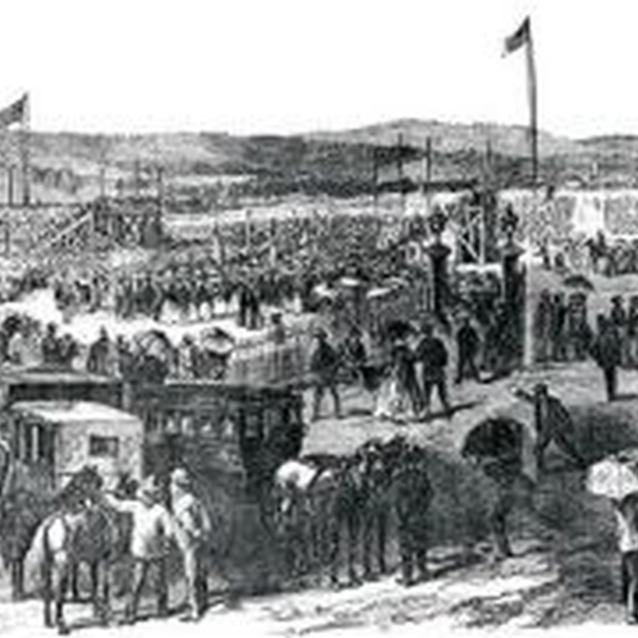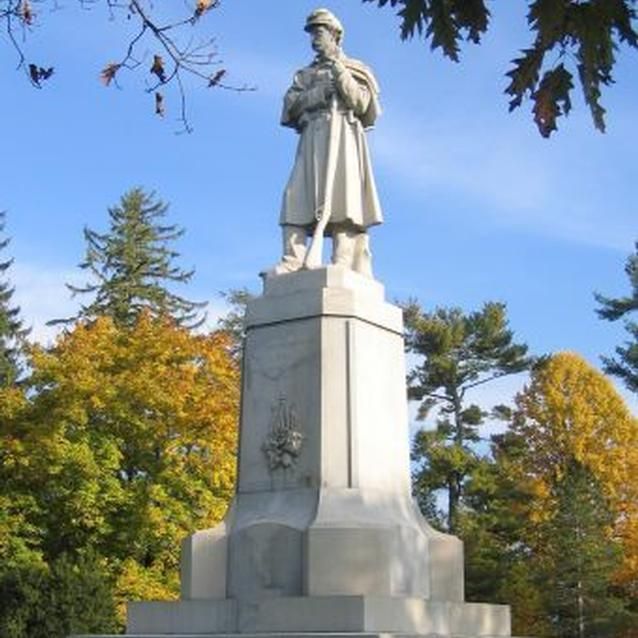"I think of the brave men who fell in the fierce struggle of battle, and who sleep silent in their graves. Yes, many of them sleep in silence and peace within this beautiful enclosure after the earnest conflict has ceased." President Andrew Johnson, at the dedication of the Antietam National Cemetery
The Battle of Antietam was the tragic culmination of Robert E. Lee's first invasion of the North. That one fateful day in September caused more than 23,110 casualties. Approximately 4,000 were killed, with many more dying of wounds or disease afterward. The peaceful little village of Sharpsburg was transformed into a hospital and burial ground which extended for miles in every direction.
Burial details performed their grisly task with speed, but not great care. Graves ranged from single burials to long, shallow trenches accommodating hundreds of corpses. For example, William Roulette, whose farm still stands behind the Visitor Center today, had over 700 soldiers buried on his property. Grave markings were constructed somewhat haphazardly, from stone piles to rough-hewn crosses and wooden headboards. A few of the dead ended up in area church cemeteries. In other cases, friends or relatives removed bodies from the area for transport home. By March of 1864, no effort had been made to find a suitable final resting place for those buried in the fields surrounding Sharpsburg. Many graves had become exposed; something had to be done.
Establishing A Plan
In 1864, State Senator Lewis P. Firey introduced to the Maryland Senate a plan to establish a state, or national, cemetery for the men who died in the Maryland Campaign of 1862. On March 23, 1865, the State of Maryland established a site for the cemetery by purchasing 11¼ acres for $1,161.75.
The original Cemetery Commission's plan allowed for interment of soldiers from both sides. However, the rancor and bitterness over the recently completed conflict, and the devastated South's inability to raise funds necessary to join in such a venture, persuaded Maryland to recant. Consequently, only Union dead were laid to rest within this cemetery. Confederate remains were re-interred in Washington Confederate Cemetery in Hagerstown, Maryland; Mt. Olivet Cemetery in Frederick, Maryland; and Elmwood Cemetery in Shepherdstown, West Virginia. Approximately 2,800 Southerners are buried in these three cemeteries, over 60% of which the name of the deceased is unknown.
An Arduous Task

Frank Leslie's Illustrated
In an effort to locate grave sites and identify the occupants, no one was of more value than two area men: Aaron Good and Joseph Gill. In the days, months, and years following the battle, these men freely gave of their time and gathered a large number of names and burial locations. The valuable service provided by these men cannot be overstated. The remains of the dead were identified by letters, receipts, diaries, photographs, marks on belts or cartridge boxes, and by interviewing relatives and survivors. Contributions totaling over $70,000 were submitted from 18 Northern states to the administrators of the Antietam National Cemetery Board. With a workforce consisting primarily of honorably discharged soldiers, the cemetery was completed by September 1867.
On September 17, 1867, on the fifth anniversary of the battle, the cemetery was ready for the dedication ceremonies. President Andrew Johnson himself attended the dedication proclaiming, "When we look on yon battlefield, I think of the brave men who fell in the fierce struggle of battle, and who sleep silent in their graves. Yes, many of them sleep in silence and peace within this beautiful enclosure after the earnest conflict has ceased."
Private Soldier Monument
One distinct feature of Antietam National Cemetery is the Private Soldier Monument, which stands in the middle of the cemetery, surrounded by the graves of his slain comrades. The colossal structure of granite reaches skyward 44 feet - 7 inches, weighs 250 tons, and is made up of 27 individual pieces. The soldier, made of two pieces joined at the waist, depicts a Union infantryman standing "in place rest" facing homeward to the north. The soldier itself is 21½ feet tall and weighs about 30 tons. Designed by James G. Baterson of Hartford, Conn., and sculpted by James Pollette of Westerly, R.I., for a cost of over $32,000, the "Private Soldier" first stood at the gateway of the Centennial Exposition in Philadelphia, Pa., in 1876. It was disassembled again for the long journey to Sharpsburg.
On September 17, 1880, the statue was finally in place where it was formally dedicated. The journey of "Old Simon," as he is affectionately known in the local area, had been delayed for several months when the section from the waist up fell into the river at Washington, D.C. Once retrieved, it was transported on the C&O Canal, and dragged by using huge, wooden rollers through the town of Sharpsburg to the cemetery. The inscription on the monument reads, "Not for themselves, but for their country."
The Cemetery Today

National Park Service, Antietam National Battlefield
Antietam National Cemetery is one of the 130 cemeteries of the National Cemetery System, a system that began during the Civil War. There are 4,776 Union remains buried here from the Battles of Antietam, South Mountain, Monocacy, and other actions in Maryland. Of those interred, approximately 1,836, or 38%, are graves of individuals whose names are unknown. All of the unknowns, with a few exceptions, are marked with small square stones. These stones contain the grave number, and a close examination of a few stones reveals a small second number representing how many unknowns are buried in that one grave.
In addition, more than 200 non-Civil War dead are also buried in the cemetery. Veterans and their wives from the Spanish-American War, World War I and II, and Korea were buried until the cemetery closed in 1953. Recently an exception to the closure was made for the burial of Keedysville resident Patrick Howard Roy, United States Navy. Fireman Roy was killed during the attack on the USS Cole and was buried in the cemetery on October 29, 2000.
If you walk to the back of the cemetery you will notice a few separate graves. Ironically, on the battlefield that led directly to Abraham Lincoln's Emancipation Proclamation, African American graves from World War I were segregated to this out-of-the-way corner.
Last updated: February 3, 2015
